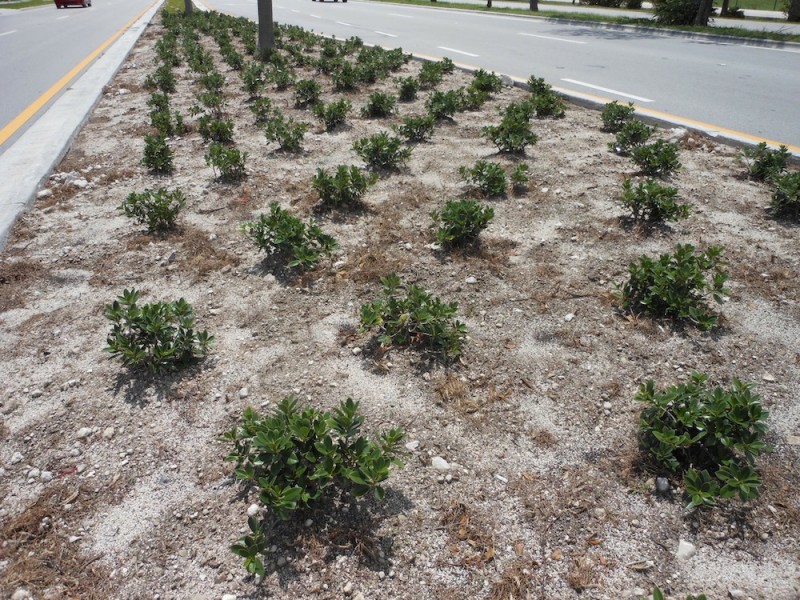Who Controls Marathon Beautification?
“Everyone is commenting favorably on the ongoing median landscaping project [in Marathon]” crowed town cheerleader and chair of the chamber of commerce John Bartus.
Well, not everyone. Even though the city has been relatively conscientious about planting native greenery in the parks and at Sombrero Beach, the new ground cover on the median is anything but native. Of even greater concern to those who worry about our environment, the city applied a crystalized form of herbicide around the plants making the sites look like moonscapes.
The plantings are primarily the work of the city’s Image Advisory Board, which is virtually controlled by the chamber. [Full disclosure: I was a member of that committee but resigned because the chamber drove the agenda via the committee’s chair Peter Chapman.] Upon that committee’s advice, the city hired a landscaping firm out of Weston, Florida – JBC Planning and Design – and that company applied South Florida concepts to its landscaping plan. The city spent $162,000 on the extensive project.
Oh la de dah, one might say. The medians now look far better in a town that desperately needs beautifying, especially with the added mulch. With many empty storefronts the city looks like a strip mall gone bad. So why make a fuss about using native plants when the entry to the city looks so much better?
Miami is not the Keys. The climate is different as South Florida (except this year!) gets far more rain than the Keys. Miami averages 100 inches of rain a year while the Keys average 32. Rain also starts earlier in the year in Miami. That means our dry season is longer and plants need to be evolved to adapt to that alternation of very wet and very dry in order to thrive.
For example, the city included Green island ficus — ficus microcarparpa – in the median plan. This low-growing shrub is used all over Florida as a median plant. The guidelines saying, “Water during dry spells, or better yet set up a regular watering schedule that allows time for the plant to dry out between waterings.” That means the city will have to water these plants during the winter, a wasteful and expensive step.
Using non-native plants requires fertilizer whereas native plants don’t need additional soil amendments on a regular basis. Native vegetation requires much less care, something the city and the chamber should have known. Maintenance costs more than no maintenance.
Trinett schefflera, another plant that Marathon, included must be fertilized three times a year – in spring summer and autumn – with a granular fertilizer.
South Florida sits on sand while the Keys are a combination of limestone and coral rock. Trees and shrubs that evolved in this area grow well in our rocky environment but those accustomed to South Florida will not do as well.
And, finally, as Joan Borel, a long-standing member of the Florida Native Plant Society, pointed out, native plants are part of a larger eco system.
“This includes all the wildlife in the Keys,” she said. “Native plants provide food for birds that live here or migrate through. A wide range of animal life co-exists with native vegetation.”
The fact that the city applied herbicide to the medians also raised many eyebrows. When the trenches for the sewer were dug seawater filled them up. In other words, the ocean and bay lie just below the surface and can easily become contaminated by both herbicides and fertilizers. Algae blooms in the bay are caused, in part, by nutrient runoff from the sugar plantations at the top of the Everglades. Using artificial fertilizer and weed killers in a place that is so dependent upon the ocean for food and for tourism is misguided at best.
There is no code in Marathon that requires planting native species in decorative, voluntary landscaping nor is there any reference to a percentage requirement for native species for large trees to be planted within a required landscape buffer for new development. Instead, it’s a question of leadership and doing the right thing.
Unfortunately, the impetus for native plants has fallen by the wayside. The Keys no longer have a chapter of the Native Plant Society since that was primarily driven by Jim Duquesnel who no longer works in the Keys. GLEE, the local environmental organization, had helped promote the statewide Green Thumb Nursery program that rewarded local nurseries for selling natives and agreeing to not sell Category 1 and Category 2 invasive exotics.
Kim Gabel, Environmental Horticulture agent for Monroe County Extension reports that when the program was started three nurseries met the requirements. Of those three, two are closed, the other is still open, but no one has evaluated it to see if it meets the requirements.
The lack of a nursery may make purchasing native plants more of a challenge but the city primarily relies upon vendors from the mainland for major contracting jobs and there are plenty of places there where appropriate plants are available. Clearly it’s possible because Sombrero Beach and Sombrero Beach Road are planted with plenty of native species. It’s just a matter of education and will.


Mr. Welber makes excellent points. There are several LOCAL landscape businesses that could have been hired and would have had the knowledge to use native plants more suited to our environment and soil. Maintenance will be costly. Another “smooth move” by the Marathon government.